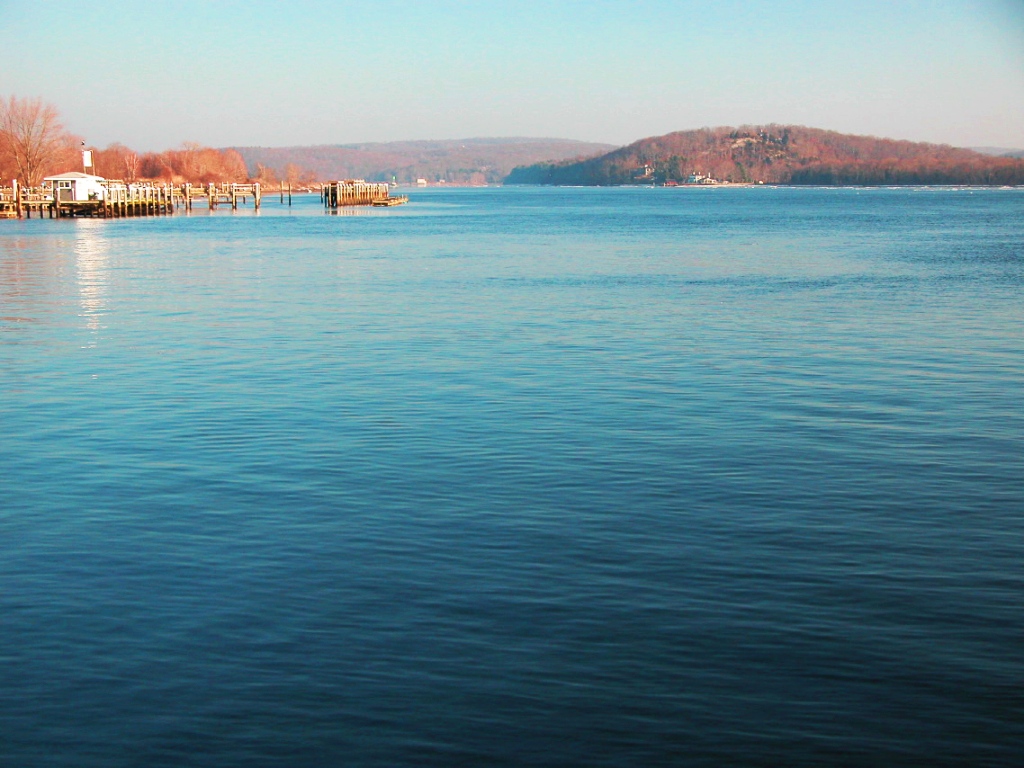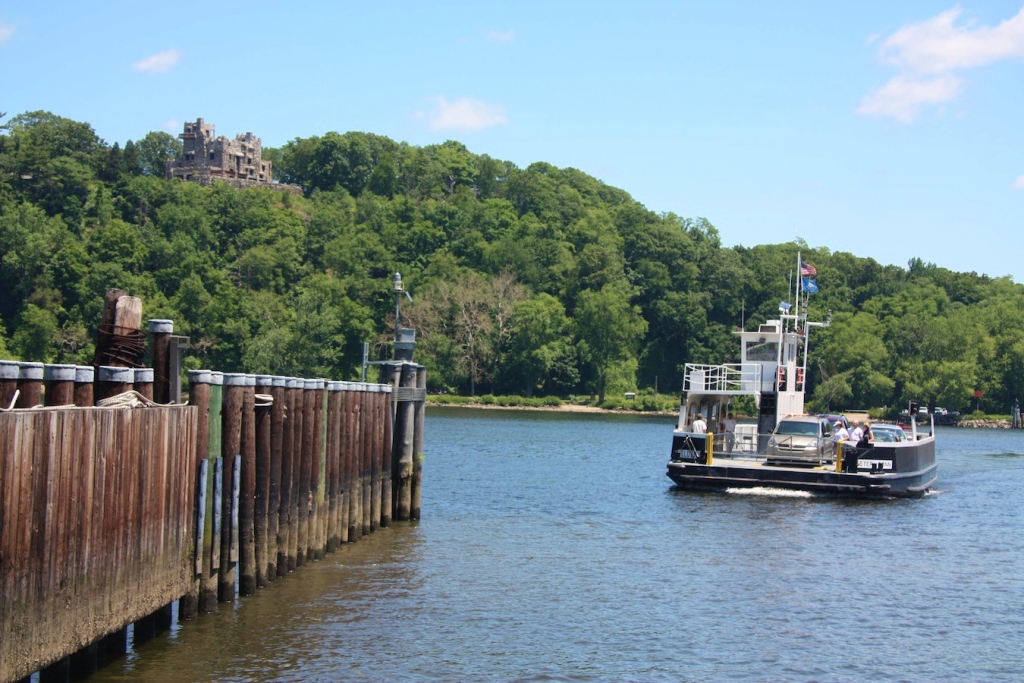Connecticut River Valley, CT
Strictly speaking, the Connecticut River Valley extends all the way from Long Island Sound through New Hampshire and into Canada, but we're interested in the southern valley in the state of Connecticut, and its historic towns: Old Saybrook, Old Lyme, Essex, Ivoryton, Chester, Hadlyme, and East Haddam.

The broad Connecticut River from the Foot of Main Street, Essex CT.
Besides being particularly beautiful, the last 100 or so miles of the river's course have figured prominently in Connecticut history. Its small towns retain the charm of a bygone era, and the river's banks are scattered with state parks and forests.
From New Haven, it's about 30 miles eastward along I-95 to the mouth of the river. About midway you pass Hammonassett Beach State Park, which has facilities for camping and picnicking, hiking trails, and a fine beach for boating, swimming, and scuba diving.
Before reaching the river's edge, the highway passes Westbrook, and then Old Saybrook, a town with picturesque views and the Katharine Hepburn Cultural Center, a cultural center dedicated to the memory of actress and longtime Old Saybrook resident Katharine Hepburn.
On the east bank of the river is Old Lyme, a renowned artists' colony for over a century, with several fine art museums, galleries, inns
Heading northwest up the river on CT 9 (Exit 3) brings you to Essex, perhaps the busiest and most charming river town, with one of Connecticut's most acclaimed inns.
Ivoryton, to the west, also has several fine inns, an old steam railroad, and a good playhouse.
Due north of Ivoryton lies Chester, a charming village with good possibilities for dining and lodging, and just across the river from it, reached by a historic car ferry, is Hadlyme, with its own hilltop castle.
North of Hadlyme, on the same (east) bank of the river is East Haddam, home of the famous Goodspeed Opera House, and several good inns.
All of this is yours in a distance of 20 miles (32 km), from Westbrook to East Haddam.
Where to Stay
Looking for lodgings along the Connecticut River? Here's a Hotel Map with Prices for finding the place you want, at the price you want, where you want:
Old Saybrook CT
One of the first European settlements along the Connecticut shoreline was Fort Saybrook at the mouth of the Connecticut River.
Fort Saybrook was built in 1635 to protect the settlers here from attacks by the warlike Pequot peoples who, unlike the other "River Indians" did not accept the coming of Europeans.
Fort Saybrook (1635)at the mouth of the Connecticut River.
In 1633 a Pequot raiding party killed nine English settlers, which spurred the English to declare war on the Pequots, who were eventually driven from their main camp at Groton.
If you drive to Old Saybrook today, follow signs reading Shore Points through the town and they'll lead you to Saybrook Point and the fort, in a small park on the left side of the road as you approach the shore.
The Katharine Hepburn Cultural Center, 300 Main Street, is a museum and cultural center dedicated to the life and career of actress Katharine Hepburn, whose home was in the Fenwick district of Old Saybrook, where she died at the age of 96. More...
Old Saybrook has an Amtrak train station north of the town.
Across the mouth of the Connecticut River, on the east bank, is the Great Island Wildlife Area and, northeast of it, the beautiful town and art colony of Old Lyme.
To get to Old Lyme, you will have to leave the tranquillity of Old Saybrook and climb back onto I-95 eastbound and take the first exit after the bridge over the river.
To go north to Essex, Ivoryton and other Connecticut River towns, just slip under I-95 and follow CT Route 9 North.
Old Lyme CT
This graceful, historic Connecticut River town is a painters' paradise, and has been for over a century.
Anyone interested in American painting—especially American Impressionism—should stop for a few hours, a meal, or overnight.
Settlers from Saybrook founded Lyme on the east bank of the Connecticut River's mouth in the 1640s, and by the 1650s the town was exporting barrel staves to the West Indies. Lyme prospered in the 1700s and 1800s, during which many of its fine old churches, houses and public buildings were constructed.
Florence Griswold Museum
Florence Griswold House, cradle of American Impressionism.
During the late 1800s and early 1900s it became a summer art colony favored by painters. The less wealthy boarded in the fine old (1817) mansion of Miss Florence Griswold on Lyme Street, now Old Lyme's most noted art museum.
American Impressionists whom Miss Griswold admired, including Charles Ebert, Childe Hassam, Willard Metcalfe, Henry Ward Ranger, and Guy and Carleston Wiggins, decorated many of the mansion's walls and doors with their work—sometimes in lieu of rent! The Florence Griswold Museum is now the headquarters of the Lyme Historical Society.
Lyme Art Association
Also on Lyme Street, the Lyme School of Art, Lyme Art Association and numerous private art galleries carry on the tradition of Old Lyme as an artists' town.
The Lyme Art Association, 90 Lyme Street, carries on the tradition of Florence Griswold by providing a gallery and juried shows for living artists making representational (not abstract) art.
The Lyme Art Association's gallery at 90 Lyme Street, just across the street from the Old Lyme Inn, hosts exhibits of works by some of the region's best representational painters and sculptors.
The association's gallery building, on the National Register of Historic Places, is an excellent venue for art, having been designed by Charles Platt, who also designed the Freer Gallery of Art in Washington DC, the Lyman Allyn Museum in New London CT, and other important art buildings.
The Lyme Art Association was incorporated in 1914, following more than a decade of American Impressionist shows in the town of Old Lyme. Early exhibitions included the works of Gifford Beal, Louis Paul Dessar, Will Howe Foote, Childe Hassam, Willard L. Metcalf, Henry Rankin Poore, Allen B. Talcott, and Carleton Wiggins.
Founding members of the association were the artists who summered in Old Lyme and stayed in Florence Griswold's house next door (now the Florence Griswold Museum): Frank Bicknell, William Chadwick, Harry Hoffmann, Wilson Irvine, Lawton Parker, William Robinson, Edward Rook, and Gregory Smith.
The gallery is open to the public for free (closed Monday), and is a prime attraction of this beautiful town renowned for its art and artists.
Lyme Academy of Fine Arts
The Lyme Academy of Fine Arts, 84 Lyme Street, is a gracious house dating from 1817 with a gallery of changing exhibits of present-day painters and sculptors.
Old Lyme Inn
The Old Lyme Inn, 85 Lyme Street, Old Lyme CT 06371, a gracious and elegant mansion, dating from the 1850's, is the village's prime hostelry, a mansion dating from the 1850s, with 13 guest rooms, period furnishings and a good dining room.
The innkeeper has found period furnishings from many New England locales for the 13 guest rooms, so you'll find canopy beds, marble-topped dressers and vanities, and antique mirrors.
Eight of the guest rooms are in the newer (1985) North Wing, which is designed to harmonize with the original mansion and other structures on historic Lyme Street.
North Wing rooms are preferable because of their better size and quiet, though the five rooms in the original mansion are certainly charming. Each room has a clock radio.
The Old Lyme Inn's dining room serves lunch and dinner. Tapestries, gleaming silver, and a formal atmosphere greet you in the high-ceilinged dining room, renowned for its fine cuisine, especially local seafood and veal. There is also a less formal grill room. More...
Essex CT
Essex is one of the most picturesque Connecticut River towns, its old houses well kept, its boatyards and marina bobbing with sleek sailing yachts and power boats.
It was called Potapaug by its Indigenous inhabitants and by English colonists long after its founding as a colonial town in 1648.
At first life here was centered on farming, but within 100 years the shipbuilding industry grew and brought Essex much greater prosperity.
As you drive into town from CT 9, Exit 3, look for the historic Pratt House, 19 West Avenue, on the left. Now owned by the Essex Historical Society, it's a center-chimney colonial with an outstanding collection of American furnishings from earliest colonial times up through the last century.
Eventually you'll come to Essex Square, the intersection of Main, North Main, South Main, and Pratt streets. Walk down Main Street past the Griswold Inn to the riverside end, known as the Foot of Main, where you'll come across the Connecticut River Museum, a dockhouse for steamboats built in 1878 and nicely restored.
Connecticut River Museum, Essex CT
Ship's models, paintings, photographs, and other exhibits recall life on the Connecticut River in years gone by. Kids will love the replica of the first submarine, the Turtle.
Take a drive from Essex Square out North Main Street to view somew of Essex's fine old mansions.
Ivoryton CT
The ivory key tops for America's pianos and organs were made here, and though the ivory industry is gone, people still visit Ivoryton for its playhouse, and fine inns.
Ivoryton, which is actually part of Essex, took its name from the ivory industry set up here by the Comstock family, who imported tusks to be shaped into covers for piano and organ keys.
Today people come to Ivoryton for the Ivoryton Playhouse, which stages excellent productions of dramatic and music works.
The station for the Essex Steam Train & Riverboat is between Essex and Ivoryton, just west of CT 9. The excursion trains run five miles (8 km) upriver to Chester, where you may board the riverboat Becky Thatcher for a river cruise before returning southward by train to Essex.
A locomotive of the Essex Steam Train.
Dickenson Brands, maker of a mild, comforting astringent distillate from the witch hazel tree (Hamamelis virginiana), is based here as well.
The Copper Beech Inn, 46 Main Street, Ivoryton CT 06442, 1.5 miles west of CT 9, Exit 3, was built as the home of a prosperous ivory merchant, and is now a local dining-place of longstanding. More...
The Ivoryton Inn, 115 Main Street, Ivoryton CT 06442, once the favorite of ivory traders visiting the town, is just a few minutes' walk from the Ivoryton Playhouse. More...
Chester CT
The picture-perfect little Connecticut riverside village of Chester is nestled in the valley of the Pattaconk Brook. It is charming, scenic, small, and wealthy.
Chester's buildings are of white clapboard, yellow brick, or somber granite, its fences of fieldstone.
Little shops and boutiques line the short main street, along with the general store, the post office, the library, and several good restaurants.
Native American deeds to the land once known as the district of Pattaconk date from the 1660s. Colonial settlers moved to the district from Saybrook in the early 1700s, and by 1836 the town was incorporated as Chester.
During the colonial period Chester was an industrial town, with a gristmill, a sawmill, and shipyards.
Chester-Hadlyme Ferry
If you're driving along the Connecticut River, the most enjoyable way to get from Chester to Hadlyme is to take the old Chester-Hadlyme ferry (map).

Note Gillette Castle peeking out from the trees (top-left).
The first ferry at the site was a private boat operated by Jonathan Warner of Chester, who started ferrying passengers across in 1769. For more than two centuries people have been crossing the broad Connecticut River by ferryboat between Chester and Hadlyme, and service continues to this day, April through November.
The ferry takes cars, bicycles and passengers across the river from April through November from 7 am to 6:45 pm on weekdays, 10:30 am to 5 pm on Saturday and Sunday. (There's no service on Thanksgiving Day.)
Hadlyme CT
Famous for the Chester-Hadlyme Ferry and the weird hilltop Victorian-fantasy castle in neighboring East Haddam, this tiny Connecticut River village draws a surprising number of visitors.
Gillette Castle
The ferry's eastern terminus lies directly beneath the hill crowned by Gillette Castle, the striking home of Victorian-era actor William Gillette, and now the centerpiece of Gillette Castle State Park.
The Victorian-era American actor William Gillette (1853-1937) created the stage role of Sir Arthur Conan Doyle's famous detective Sherlock Holmes, and made a fortune playing in that role.
In 1914, Gillette realized a lifelong dream by beginning construction of his fantasy home: a castle on a hilltop which enjoyed a sweeping panorama of the Connecticut River, including the historic Chester-Hadlyme ferry, whose eastern terminus lies right beneath the castle's perspective.
Over five years and a million dollars later, the result was a supremely weird mansion of Connecticut fieldstone named "The Seventh Sister," complete with its own 3-mile-long excursion railroad, and a room designed to look like the sitting room at 221B Baker Street, Sherlock Holmes's fictional residence in London.
Inside the castle, on River Road in East Haddam, just north of the Hadlyme town line, Gillette gave vent to his passion for detail and exotica, bringing furnishings from around the world and specifying in great detail the form that was to be given to the intricately carved oak trim and the ingenious wooden door latches.
The narrow-gauge railroad is gone, but forest paths, picnic tables, and river vista spots have replaced it. Admission to the park and picnic grounds is free, but there is a fee to visit the hilltop castle-museum.
East Haddam CT
From Hadlyme, drive northwest a few miles to East Haddam (map), a village noted for its music as well as musical drama, where you'll find the wonderful old Goodspeed Opera House and neighboring Gelson House Restaurant & Inn. Alternative lodging is at the East Haddam Country Loft.
Goodspeed Opera House
The Goodspeed Opera House, a riverside Victorian gem at 6 Main Street built in 1876, has been carefully restored by Goodspeed Musicals to serve as a venue for American musical theater.
The setting by the Connecticut River and bridge is so picturesque that it's worth the ride just to see the exterior, but if you have the time, take a tour of the interior.
Best of all, see a musical play. The specialty is the revival of early musicals and the production of new works. A number of Goodspeed shows have moved onward and upward to Broadway.
Three musicals are offered each season beginning in mid-April and continuing through mid-December with performances every day except Monday and Tuesday, and a matinee on Wednesday.
Goodspeed Musicals also operates the Norma Terris Theatre at 33 North Main Street in Chester CT, inaugurated in 1984 to develop new musicals and nurture emerging artists. The 200-seat theater, housed in a former knitting needle factory, was named for actress Norma Terris, star of Jerome Kern's Showboat and a patron and trustee of the Goodspeed Opera House.
